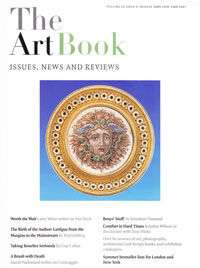 |
Review of Lost Secrets of Flemish Painting
The Art Book, Volume 12, Issue 3.
Published by Blackwell Publishing Ltd, 9600 Garsington Road, Oxford OX4 2DQ UK
Living and traveling in royal and aristocratic circles in early seventeenth-century London, Sir Theodore Turquet de Mayerne took particular interest in the painting practices of several of his friends and acquaintances. These included Peter Paul Rubens, Anthony Van Dyke, Somers, Greenbury, Janson, Mytens and others, as de Mayerne indicated in the title to his manuscript, Pictoria, Sculptoria et quae subalternarum atrium - Painting, Sculpture and its pertinence to the other arts. It is a treatise written in Latin, French, Italian, and German, a common scholarly practice at the time, with sections also in the English of the period. It is dated 1620, but additions were made between 1632 and 1644.
|
|
In de Mayerne's leisure hours, when not attending to his duties as physician to James I, Charles I and Charles II, he visited the studios of the painters. There he chatted with them and noted down both their own words and his observations of making, mixing and use of pigments, oils, driers and solvents, the preparation of the ground and undercoats, the making and cleaning of brushes, the making and application of varnishes, and many other aspects of studio practice – even addresses of artists' colourmen in London are given. He also recorded instructions on how to paint landscape: clouds, fields, water, wood, snow, buildings and so on. He gave methods for creating shadows when using different pigments and included the arrangement of pigments on several palettes. De Mayerne ordered all this by painter and so the practice of Rubens or Van Dyke, for example, can be consulted individually, although what is particularly interesting is the range of 17th century studio practice, techniques and especially, the wide variety of pigments made and used.
De Mayerne's manuscript is a veritable treasure chest about painters who were working in England in the 17th century. Although some were English, such as Edward Norgate, it was the tradition and the craftsmanship of the Flemish, French, Dutch, German and Italian painters that brought new methods to English painting. So not only does de Mayerne provide a foundation for studying European painting practice at the time, but he also shows how these practices contributed to the flourishing of English painting into 18th century.
The editor, Donald C. Fels Jr., has himself contributed an important and significant essay. Fels sets the de Mayerne manuscript in historical context and devotes chapters to the materials of seventeenth-century studio practice: the craft of painting, varnishes, solvents, drawings media, and a chapter on Ruben's painting system. Finally, Fels describes the methods by which a modern painter can use the traditional recipes and methods in order to replicate the craft described by de Mayerne, in what he calls the Fat oil Essential oil Layering System (FELS System).
Fels is a period instrument maker and a painter, so his analysis and application of seventeenth-century practice are informed by the knowledge and sensibility of a practitioner, one who also makes and sells amber varnishes based on recipes found in the de Mayerne manuscript. It was his search for traditional varnishes that stimulated his interest in this extremely important seventeenth-century document, one that is essential to artists interested in traditional methods and materials and, of course, to instrument makers. They need no convincing and, once art historical scholars of seventeenth-century painting have consulted this book, nor will they. For in it they will discover new paths into the perception and understanding of Flemish, Dutch and English painting that can only lead to new historical insights.
This is a very important book, one that is essential for both libraries and individuals.
-Patricia Railing
Director, Artists - Bookwork.
Published by Blackwell Publishing Ltd. Reprinted with permission. |
